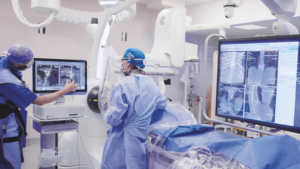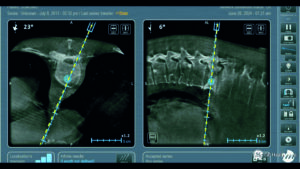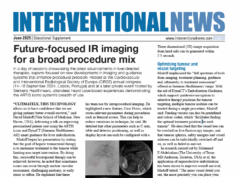This advertorial is sponsored by GE Healthcare.

“For us, the main clinical objective is accuracy. Precision is key for interventional radiology [IR] procedures,” said Lambros Tselikas** (Gustave Roussy, Villejuif, France), who discussed how he and his team have leveraged cone-beam computed tomography (CBCT)-guided navigation to elevate their procedural efficiency.
CBCT-guided percutaneous procedures have gained prominence over the last decade across interventional oncology, radiology and pain management. Real-time CBCT imaging is used to guide the insertion of needles and other instruments to target specific regions of the body, with applications ranging from biopsies and drainages, to the delivery of treatments such as cryoablation.
In Lambros’s practice, procedures that involve the placement of a needle tend to be more technically challenging, more specifically when the needle trajectory is angulated and deep, which is increasingly the case for bone procedures. Most commonly, Lambros and his team perform diagnostic and therapeutic interventions using the Alia IGS 7(1) for augmented imaging, in combination with the Imactis Navigation system—both developed by GE HealthCare—to plan and navigate the patient’s anatomy during percutaneous procedures.
One of the key benefits of CBCT-guided procedures is their ability to provide detailed, cross-sectional images of internal structures. This capability allows for precise navigation to the area of interest, reducing the risk of complications and improving overall procedural outcomes.
The Imactis Navigation system collects detailed CBCT images to create a virtual, three-dimensional model of the patient’s anatomy. The system uses electromagnetic navigation to increase the accuracy of procedures ensuring that clinicians can navigate complex anatomies while avoiding critical structures and organs.
 “What I find interesting when using the Imactis system with the addition of CBCT is, due to the wide bore, you can very easily jump from one modality to another,” he detailed. In practice, Lambros is able to plan the trajectory of the needle on the initial CBCT scan while the patient’s arms are down, and then precisely choose the entry point using Imactis. This way, Lambros and his team can view the virtual anatomical mapping alongside the real-time control images to proceed with absolute confidence.
“What I find interesting when using the Imactis system with the addition of CBCT is, due to the wide bore, you can very easily jump from one modality to another,” he detailed. In practice, Lambros is able to plan the trajectory of the needle on the initial CBCT scan while the patient’s arms are down, and then precisely choose the entry point using Imactis. This way, Lambros and his team can view the virtual anatomical mapping alongside the real-time control images to proceed with absolute confidence.
“We know based on our clinical experience that a good entry point can really make the difference, especially for a tricky case—with Imactis, this is a huge advantage,” Lambros said. “Then, following the needle insertion, we can continue using our advanced guidance tools such a Needle ASSIST(2) (GE HealthCare) which can help to reduce dose and increase the number of patients we can treat. The key benefit of using Imactis Navigation for CBCT with the GE HealthCare Angio system, is to bring together complementary navigation and guidance tools in an easy-to-use, versatile manner, to make difficult cases easy.”
 Although centres today seek to offer the highest-quality treatment to their patients, investment in new technologies can appear unattainable due to cost-efficiency and time to installation. GE HealthCare interventional chief executive officer Arnaud Marie told Interventional News hat he heeded this challenge, and explained that their vision for Imactis was to be able to “integrate with already available CT-scanners and innovations emerging from start-ups, academics and other large companies, so we can leverage our ecosystem to seamlessly provide the best-in-class solution”. With this ethos in mind, Marie explained how GE HealthCare has collaborated with companies such as Centerline Biomedical—a provider of X-ray navigation technology—to help to bring beneficial solutions to market.
Although centres today seek to offer the highest-quality treatment to their patients, investment in new technologies can appear unattainable due to cost-efficiency and time to installation. GE HealthCare interventional chief executive officer Arnaud Marie told Interventional News hat he heeded this challenge, and explained that their vision for Imactis was to be able to “integrate with already available CT-scanners and innovations emerging from start-ups, academics and other large companies, so we can leverage our ecosystem to seamlessly provide the best-in-class solution”. With this ethos in mind, Marie explained how GE HealthCare has collaborated with companies such as Centerline Biomedical—a provider of X-ray navigation technology—to help to bring beneficial solutions to market.
To Marie, IR is a dynamic field defined by exponential growth in clinical advancement, exemplifying this through the development of genicular artery embolization (GAE) and musculoskeletal (MSK) interventions. In response to these leaps, new navigation software using X-ray and electromagnetic energy, as well as robotic elements has rapidly evolved.
 “My vision is that there will be a convergence of technologies to provide integrated systems that will enable delivery of these procedures in a much more predictive, democratised and safer way for both for the patient and the interventionalist through reducing exposure to radiation.”
“My vision is that there will be a convergence of technologies to provide integrated systems that will enable delivery of these procedures in a much more predictive, democratised and safer way for both for the patient and the interventionalist through reducing exposure to radiation.”
Marie shared that their intent is to initiate a “strong step toward automisation”, using the Imactis CT-Navigation system in collaboration with “several” companies who specialise in robotics. He believes that “lighter, portable and flexible” robotic technology can achieve improved needle placement in combination with GE HealthCare’s navigation software, producing an all-in-one solution.
While maintaining quality of care, Imactis CT-Navigation is aimed to give interventional radiologists better control over patient care. As minimally invasive procedures become more frequently used for a wider range of patient cases, Marie believes this technology can provide confidence of care, making complex procedures accessible to more clinicians while maintaining quality of care.
In early 2023, GE HealthCare acquired Imactis—a France-based company developing ergonomic stereotactic needle guidance through CT-navigation and CBCT-navigation—which the company states is a part of a broader strategy to improve the workflow of interventional radiologists and become standard of care. The Imactis CT-Navigation system, which includes an integrated workstation, guidance software, and disposable procedure kit, is currently approved under the European Union’s Medical Devices Regulation (MDR).
Disclaimer:
*IMACTIS CT-Navigation is CE Marked and US Food and Drug Administration (FDA) approved. IMACTIS CBCT-Navigation is CE Marked but not yet FDA approved and is not available for sale in the USA. IMACTIS Navigation may not be available in all countries. Refer to your sales representative for more information.
**Tselikas Lambros is a paid consultant for GE HealthCare and was compensated for participation in this article. The statements by Lambros described here are based on his own opinions and on results that were achieved in his unique setting. Since there is no “typical” hospital and many variables exist, i.e. hospital size, case mix, etc. there can be no guarantee that other customers will achieve the same results.
- IGS 7 refers to Discovery IGS 7 and Allia IGS 7 system.
- Needle ASSIST solution includes TrackVision 2, stereo 3D and requires AW workstation with Volume Viewer, Volume Viewer Innova. These applications are sold separately.










